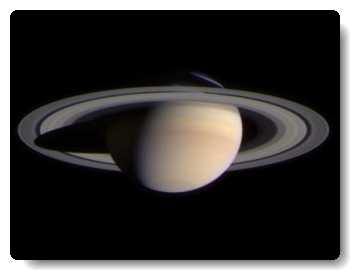Cassini reveals new and interesting details about Saturn, its rings and its moon Titan

Saturn in the eyes of Cassini
The Cassini spacecraft, which began its journey through the Saturn system, its rings and moons, about a month ago, discovered lightning and a new radiation belt in Saturn. The spacecraft also discovered a halo around Titan, the planet's largest moon.
The scientific devices for detecting radio waves and plasma, which are on the spacecraft, detected radio waves, which are created by lightning. "We find the same background noise that can be heard when listening to an AM radio broadcast during a thunderstorm," said Dr. Bill Kurth, deputy director of radio and plasma instrument control at the University of Iowa in Iowa City. "These storms are significantly different from the storms we discovered 20 years ago."
Cassini discovered that the radio waves from lightning are quite random and appear without any repeating pattern. There is a big difference between the number of lightning events from day to day, sometimes there is almost no lightning or none at all. The difference suggests the existence of several short storms in middle to high latitudes. The Voyager spacecraft detected lightning, resulting from an extensive system of low-latitude storms. These storms lasted for months, and their behavior seemed more or less constant from day to day.
The differences in storm characteristics may be due to different shading conditions between the 1980s and now. During the Voyager era, when lightning was first discovered, the rings cast a very deep shadow around Saturn's equator. As a result, the atmosphere in the shadow region, which was located near the hottest regions of Saturn's atmosphere, was extremely cold. The mixing between the warm and cold zones may have given rise to these long storms. However, during Cassini's closest approach and entry into orbit around Saturn, summer prevails in Saturn's southern hemisphere, and the ring shadow falls mainly on parts of the northern hemisphere, so the hottest and coldest regions are far apart.
Cassini's magnetospheric imager has made an important discovery. He discovered a new radiation belt just above Saturn's clouds that extends to the inner edge of the D ring. This is the first time that a radiation belt has been discovered in Saturn using remote sensing.
The new radiation belt extends around the planet. It was discovered by the emission of fast neutral atoms, which are formed when ions magnetically trapped in the belt interact with gas clouds inward toward the planet from the perspective of the D ring, Saturn's innermost ring. The meaning of this discovery is that the radiation belts extend to areas much closer to the planet than previously thought.
"The new radiation belt escaped detection by previous spacecraft that visited Saturn. This discovery showed us something we did not expect, the ability of the particles from the radiation belt to 'jump' over obstacles such as the rings of Saturn without being absorbed by the rings on the way," said Dr. Donald G. Mitchell, Instrumentation Scientist at the Center for Magnetospheric Imaging at the Applied Physics Laboratory at Johns Hopkins University in Laurel, Maryland, USA.
Titan, Saturn's largest moon, also requires attention. Cassini's Visible and Infrared Mapping Spectrometer photographed Titan glowing both day and night. The source of the glare is the emission of methane and carbon monoxide gases from the large and thick atmosphere of the moon.
"Not only does Titan put on a huge light show, but it also teaches us more about its dense atmosphere," said Dr. Kevin Baines, a member of the Visible and Infrared Mapping Spectrometer science team at NASA's JPL Jet Propulsion Laboratory. . "The amazing part is that the size of this gas emission or glow reaches up to one-sixth the diameter of the moon."
The fluorescent methane glow, illuminated by the sun through Titan's atmosphere and revealing to us the thickness of the atmosphere, which stretches for more than 700 kilometers, was expected. However, the nocturnal glow, which consistently shines on Titan's dark side, initially surprised scientists.
"These images look as if we are looking at Titan through alien eyes. Titan shines in the frequency range on the border of the infrared. "If we were aliens, we would have a hard time sleeping well at night on Titan, because there would always be light," Baines said.
The Cassini Huygens mission is a joint mission of NASA, the European Space Agency and the Italian Space Agency. The Jet Propulsion Laboratory, a division of the California Institute of Technology in Pasadena, manages the mission for NASA's Science Mission Directorate. The Jet Propulsion Laboratory designed, developed and built the Cassini spacecraft.
The news from NASA
